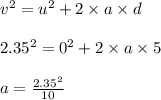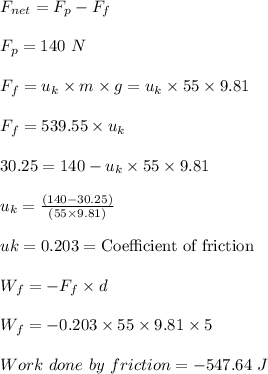
Physics, 30.06.2021 03:10 JvGaming2001
A 55-kg block, starting from rest, is pushed a distance of 5.0 m across a floor by a horizontal force Fp whose magnitude is 140 N. Fp is parallel to the displacement of the block. The final speed of the block is 2.35 m/s.
a) How much work was converted to thermal energy? What work did friction do on the box?
b) What is the coefficient of friction?

Answers: 3


Other questions on the subject: Physics

Physics, 21.06.2019 22:30, jadalysrodriguez
The percent efficiency of a machine can never be 100% (or greater), because in the real world some energy is always converted into a. heat b. work c. input force d. output force
Answers: 1

Physics, 21.06.2019 23:20, lailabirdiemae
Initially, a particle is moving at 5.33 m/s at an angle of 37.9° above the horizontal. two seconds later, its velocity is 6.11 m/s at an angle of 54.2° below the horizontal. what was the particle's average acceleration during these 2.00 seconds in the x-direction (enter first) and the y-direction?
Answers: 1

Physics, 22.06.2019 14:40, akitchen10
A5 foot by 5 foot box culvert is buried 6 feet beneath the surface of the ground. a crosssection of this very long culvert (into and out of the page) is illustrated below. assume that the soil in which the culvert is buried has the following properties: jt = 120 pcf, w = 12%, ko = 0.50, ka = 0.33, and kp = 3.00. calculate the total horizontal force per unit length of culvert (fh) felt on one of the vertical faces of the culvert.
Answers: 1
You know the right answer?
A 55-kg block, starting from rest, is pushed a distance of 5.0 m across a floor by a horizontal forc...
Questions in other subjects:






Mathematics, 28.01.2020 14:01

History, 28.01.2020 14:01











